There might be a recession in 2023. Or, maybe not!
But whatever happens, it’s pretty certain that an increasing number of CEOs are deciding that they choose not to take part. They’ll opt out. That’s trend #6 of my ‘23 Trends for 2023′ series.

To opt-out is to choose not to participate in something.
Right now, the conventional wisdom – the wisdom of crowds – seems to be that if we are headed for a recession in 2023, we’d better hunker down, scale back, slow down, take it easy, be cautious, reduce spending, defer our actions, wait it out, take things slow, put things on pause.
And that is just plain idiotic. History tells us so – because those who choose to opt-out of conventional wisdom are those who win.
The trend that will unfold in 2023 has to do with the decision by many to choose not to participate in the current or upcoming recession, economic downturn, or whatever we want to call this period of economic uncertainty. We don’t really know if we are in a recession – one moment we seem to be, the next moment not. Clearly, it’s pretty volatile out there and uncertainty rules our future. In the context of that, it’s important to focus on the long-term goal, not the short-term volatility.
Because history tells us so!
What We Know from Previous Downturns
Several of my talks in 2022 focused on this theme, and used some powerful insight gathered during my preparatory research based on a theme I was already sharing after the 2001 and 2008 economic downturns: long-term winners are those who chose not to participate in the downturn! It seems simple but is pretty critical – when uncertainty stares you in the face, double down on innovation and transformation, and refocus on the long-term view!
Here are two key things we learned from the 2008-09 global economic meltdown. First, ‘winners’ grew at a 17% compound annual growth rate during the downturn compared to 0% among the ‘losers.’
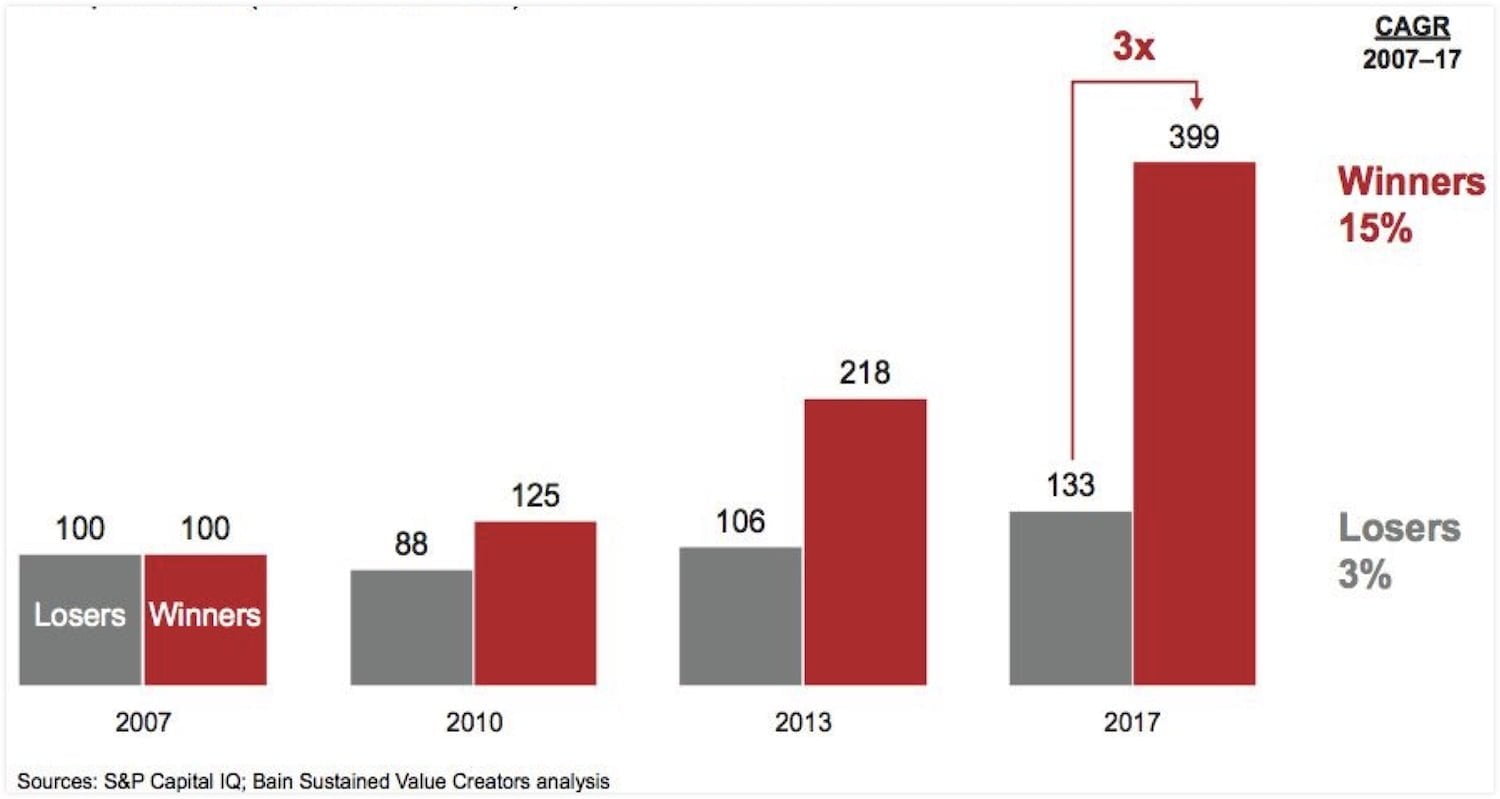
Second, those ‘winners’ locked in gains of 13% CAGR in the years after the downturn compared to the ‘losers’ stalling at 1%.
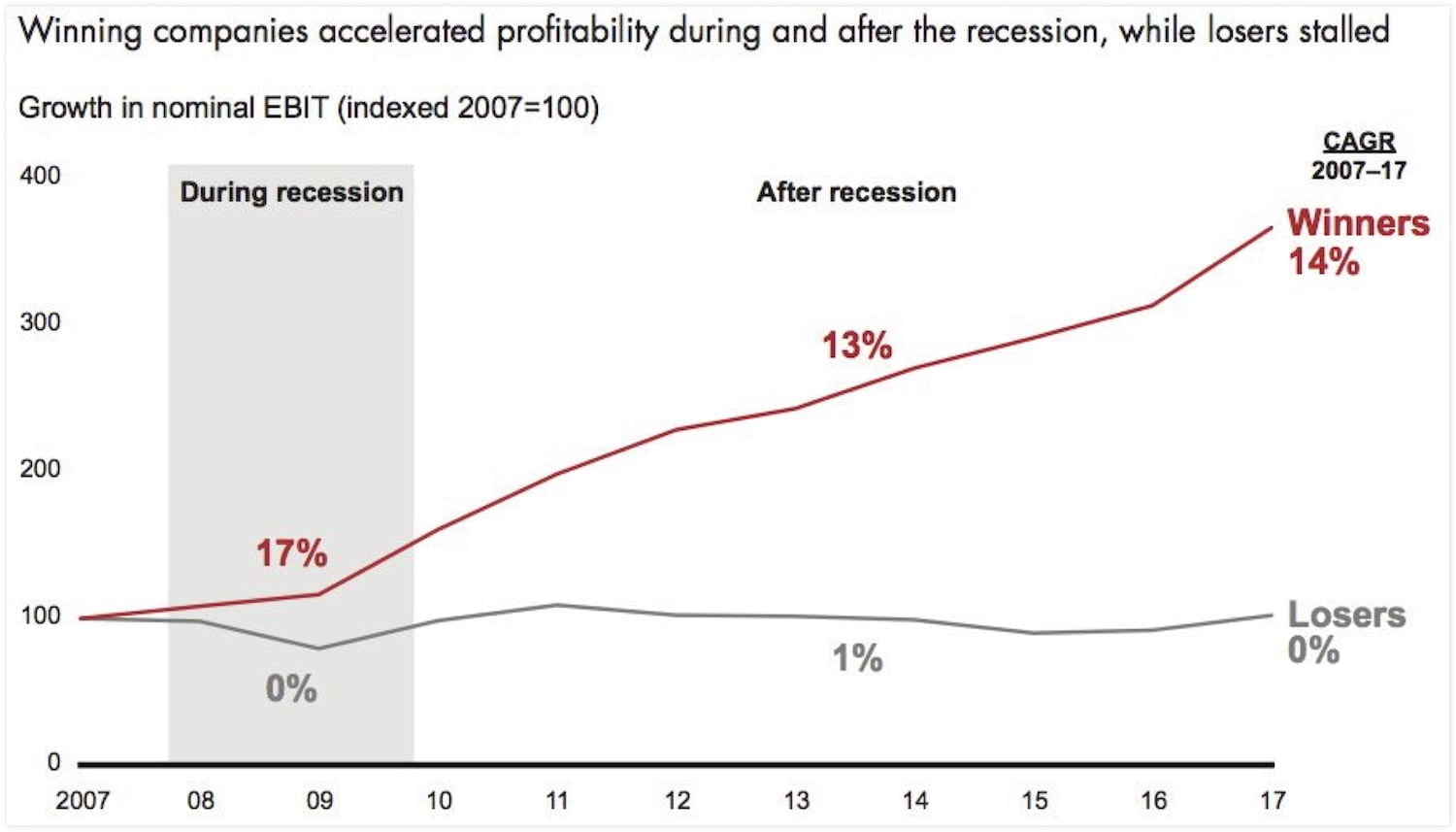
In other words, by opting out of the common narrative – ‘it’s a recession, cut back, hunker down and make sure you ride it out – and by choosing instead to go into the future full throttle, they emerged much better positioned for that future.
It’s a powerful lesson. Watch this short clip from my keynote in London, UK earlier this year around this theme – and my story about what goes wrong if you fall prey to a mindset of negativity driven by economic gloom.
The story in the video is key to my ‘innovate for the future despite uncertainty’ message – it’s early 2009, and the global economic meltdown from the crash of 2007-08 is well underway. I’m on my way to see my client Rockwell Collins in Cedar Rapids, Iowa – and the radio is advertising this book of doom and gloom on the radio. That didn’t sit right with me – and so I began to explain why! Watch the video to get the gist of the story – this is important stuff with respect to dealing with doom and gloom.
Bottom line: if you’ve got a recession now staring you in the face it’s a pretty brutal time to think about the future. it’s a pretty easy time to be depressed and spend your time focusing on the negativity around you. Yet that is absolutely the wrong thing to do.
So what do you?
Don’t do that. It’s simple!
Refuse to take part in the recession!
And in the rest of this post, I’ll share with you insight that I’ve shared with organizations that have adopted this mindset!
The Differentiators
Those who fail to thrive in a downturn do these things:
- they perform heavy cost-cutting
- they scale back of R&D
- they see a lot of quality talent lost due to cutbacks
- they stray out of their core business to try to find a path forward
- they take a wait-and-see approach
Those who achieve significant CAGR despite a downturn do these things:
- played on the offensive but selectively
- they accelerated R&D spend
- they focused sales efforts on top customers
- they maintained or boosted marketing while others cut back
- they focused on digital customer experience
Notice a difference?
‘The Trend into 2023
Here’s what will happen in 2023 – some will choose not to take part!
Consider this Grant Thornton survey:
- 50% of major organizations planned to double down on innovation in a downturn
- “They don’t intend to just retrench and try to ride it out. Most are counting on continued investment in technology and innovation to push them through.”
As the study notes:
“Most companies believe a recession is coming, and the key is to plan now – then invest in, innovate and execute on the core business during the downturn, which will position companies that do to dominate the recovery. Companies that approach a recession with the discipline to control expenses and manage cash, but with a matching vision to align ongoing investment with strategy and opportunity, can win the downturn rather than merely surviving it.”
People Always Assume the Worst!
Don’t take part! The first step is to shift your mindset.
Consider this video. It’s 2011. I’ve got 2,000 clients of @TRowePrice in a room, and I’m talking about economic downturns & mindset – and doing a live text message poll to assess their thinking. This was shortly after the economic downturn of 2008-2009.
Watch it unfold! 2/3 of the people in the room thought a recovery was far away. The result? Many would have missed out on the longest-running economic boom in history.
Is that you today? Not if you choose not to take part and heed the lessons above!
Moving through the Seven Stages of Economic Grief Faster
Here’s what happens during a potential downturn: too many organizations enter into a state of absolute paralysis when a recession looms and idea factories are being turned off. The result is that we don’t just enter a potential economic recession, we go into another idea recession, similar to what occurred with the last downturns in 2001 and again in 2008. But the winners who achieve positive CAGR don’t think like that.
What is so different this time is the absolute speed with which ideas are shutting down — the paralysis in some organizations at the leadership level is absolutely stunning. This got me thinking about the fast-paced events of the last few weeks in the context of the seven stages of economic grief. Every time we see a big stock market pullback and talk of recession, people and the organizations they work for can go into a state of shock. Then, there is the process of denial – it can’t be that bad. But as the reality of the downturn becomes clear – supply chain challenges, staffing shortages, and more – denial kicks in. Inevitably, anger is the result – gas prices anyone? Finally, they begin to move through the process of bargaining, depression, and eventually acceptance and hope.
What if organizations could move to the latter phase faster?
History shows us that it’s those organizations who eventually win in the race to the future.
History tells us that only 10% of organizations become breakthrough performers during a recession – because they decide to double down on innovation and opportunity despite lingering and pervasive uncertainty! 60% are simply marginal performers during a downturn, undertaking the bare minimum to get by. The remaining 30%? They either don’t make it – they go bankrupt, are bought out, or disappear altogether. I came to realize once again, with the fast-moving events of 2022 into 2023, that things have happened so fast that many organizations still find themselves in the “shock” and “denial” phase. And here’s what we know from the historical record – they’ll be the innovation laggards, among that 60% or 30%.
Then there are the innovation leaders – the 10%. They’re prepared to keep the idea factory running, maybe not at full tilt, but running nevertheless. They know that despite the fact that vast sections of the economy are tanking, there are still growth markets and opportunities to step ahead of your competitors. There are opportunities to attack new markets, streamline operations, build new brands, and grab customer mindshare in new ways.
There are plenty of opportunities to turn ideas into innovation. It all depends on where you want to be as, inevitably, we come out of the downturn.
So, economic volatility? Take a chill pill!
Back in 2008, with the global economic meltdown, I wrote a post about ’10 Fundamental Trends That Don’t Change with the Meltdown.’ I thought I’d give it a small bit of an update since the message still holds.
So what are the trends that will drive future growth? Off the top of my head, there are several:
- Growth markets will continue to emerge. Back in the 19th century, the head of the US Patent Office stated that “everything that can be invented has been invented.” Such silliness! Right now, there are hundreds of thousands of new products, markets, industries, and ideas being built and explored. The future isn’t over. Its arrival has just slowed to a degree in some industries; in other industries, this market blip and volatility will barely be noticeable.
- Leaders in existing markets will grow through innovation. My own gut feel is that there are a lot of organizations out there approaching this recession differently, based on lessons learned from previous downturns. They’re innovating in their markets; they’re working on customer retention; they’re investing in customer service in order to keep competitive; they’re talking about how to grow in a down market. I’m certainly seeing this given my advance bookings going forward. People want to talk about innovation and the future. That’s a great sign that the recovery is already underway!
- Healthcare and medical science will continue to see a significant transformation. A simple fact has emerged from Covid – our world of healthcare has changed forever! Yes, there are deep problems with staffing, skills, burnout, and spending – but beneath the surface, new medical knowledge is growing at a furious pace, science is accelerating and new discoveries are exploding – mRNA-based medicine is a massive change. This is a huge, long-term trend, but has big implications with the emergence of new careers, industries, professions, and companies. I’m bullish on science, and health is science.
- Green energy will continue to have more momentum. Some argue that the meltdown will defer everything having to do with this effort. I disagree; I think the corporate sector has discovered the cost-benefit that comes from green projects, and so they will continue to invest, which will drive innovation. Oil is over, batteries are the future, and gas cars are DOA given energy prices. We’ve passed the point where carbon industry leaders believe that doing the same old thing as in the past is going to continue in the future. I don’t see leading-edge research into solar, wind, and other alternatives slowing down any time soon.
- Technology will continue to hyper-innovate. Technology now dominates the disruption and pace of innovation in every single industry. Aside from the hype trends such as crypto, meta, and Web3, there continue to be massive opportunities for technology-driven growth. Cars become computers, agriculture moves to 24-hour farming, and retail continues to evolve to online sales domination. The fact is, I don’t see hi-tech innovation and R&D slowing down. Indeed, during the last recession, some of the biggest innovations – the iPhone – emerged from the minds of those inventing the future. There are a lot more billion-dollar markets still to emerge.
- Agility and flexibility will dominate. In the next several years, the manufacturing industry – globally and locally – will take the lessons being learned right now about supply chain challenges and relentless volatility, and turn those into opportunities for business model reinvention. As they do so, they’ll undergo a fundamental transformation in their thinking, structure, and capabilities that will ensure their success.
- The global idea machine will continue to influence innovation. Look, the Internet continues to have a profound impact on everything we do. Scientific discovery is speeding up; new discoveries continue to go forward at a furious pace. Eco-building design concepts are debated, shared, and then go global in an instant. From the global mind comes unprecedented innovation, new products, new companies, and new industries. And the fascinating thing is that there is a lot of backyard and garage tinkering going on right now, and that’s where the next product/market breakthroughs will come from.
- The next generation takes over. The boomers are a dispirited bunch right now; there’s not a lot of passion and enthusiasm with some of them to change the future, particularly given the status of their 401(k) plans – but they are now leaving the economy. At the same time, some of the younger generations are witnessing their first-ever downturn, and it’s probably pretty terrifying. Yet, they’re an entrepreneurial bunch, who have grown up with a mindset that inhales change, pursues multiple different opportunities, and collaborates like nothing we’ve ever seen before. I think they’ll shake things up pretty quickly.
- A faster world happens, well, faster. Simply put, faster news cycles mean that people get through difficult periods faster, at least in terms of mindset. Above I mention the ‘7 stages of economic grief’. Think about whether you think people are moving to the acceptance phase more quicker. I believe they are, and I think this faster attitude shift, compared to a slower pace of acceptance in previous recessions, means that innovation will drive us out of this faster than we expect.
- Transformative thinking drives growth. Last but not least, we can’t discount the impact of folks like me who know the lessons of previous downturns. Every downside has an upside; breakthrough performers are those who focus on the future despite volatility. Big opportunities come from big ideas sponsored by leaders with big dreams.
How Do You Do This?
I’ve long been in the right mindset. When the global economic recession that followed the financial collapse of 2008 was underway, Business Week ran an article, “10 Worst Innovation Mistakes in a Recession.” I took exception to the article since while it’s easy to point out mistakes, it can be harder to indicate what you should be doing. At the time, I was already rapidly adjusting my theme to one of “how you can innovate during a recession.”
Much of what I was talking at the time about resulted from the opportunity I was already seeing firsthand among numerous innovative strategies from the CEOs of my clients. I kept modifying my message at a rapid speed to incorporate a vast variety of ideas from these and other sources. So in response to the Business Week article, I posted a comment on the article, noting that they should provide some ideas, not just a list of mistakes. This is what I wrote:
- Focus your team — relentlessly — on growth. Early in 2009, I keynoted a global food organization in Las Vegas. The CEO was on stage before me — and spoke about the recession for about one minute. He then spent 19 minutes speaking about the growth opportunities that the organization could pursue by moving beyond a recessionary focus. That’s what everyone needs to do right now. There are growth opportunities in every industry. Focus on them!
- Respond faster. When I keynoted a food industry summit in New York at the start of the recession, we spoke of the need to respond faster to the fact that consumer preferences were changing more rapidly than ever before. More people eating at home, sensitive to dollars, and looking for food comfort. Reformulate new brand and product options faster. Just do it. Don’t study — do.
- Invest in the brand. Brands can become weaker in a recession, particularly as consumers scramble for value. Decide where you want to reposition your product/brand, and act fast to do it rather than studying it to death.
- Mix it up. Don’t assume that what worked before the recession will work now. Try out a lot of ideas, particularly around value. “I’m experimenting rapidly with price points and product mix.”
- Invest in experience. Lots of your staff will be down in the dumps and spinning their wheels. Get a message out that NOW is the time to invest in new ideas, experiences, and activities. Try things out, to build up the collective experience of your team.
- Kill off the innovation killers. Reframe your team, so that they are thinking “what a great idea,” rather than viewing with suspicion any new ideas. Remember — everyone is worried about being laid off, and paranoia sucks the life out of innovation faster than anything else.
- Collaborate within the industry. When I keynoted the American Nursery and Landscape Association in the early stages of the downturn, I stood in awe of the blog they were running that was offering practical, on-the-ground, easy-to-implement ideas that retailers could put into their stores NOW.
- Seek ideas. Go knowledge farming once a day, looking for ideas on customer service, operations, IT strategies, and just about anything else. There’s a flood of ideas out there — now’s a great time to chase them down and do things.
- Partner up. Sure, resources are scarcer during a recession. That’s why you can speed up innovation with anything — from advertising to customer service, business model implementation, IT strategy, opportunities for operational excellence, or just about anything else — by seeking partners to help you out. That will help you achieve key goals faster.
- Get over it. Lots of organizations are still stuck in the anger and denial phase of the Seven Steps of Economic Grief. Make a decision to get into the acceptance stage, and move on. This will recession will pass, just like every other one.
The question really comes down to this – when do you innovate? I took that head-on in this clip from 2009.
Choice!
Be a Part of the 10%
“History tells us that 10% of organizations become breakthrough performers during a recession – because they decide to double down on innovation and opportunity despite lingering and pervasive uncertainty!”
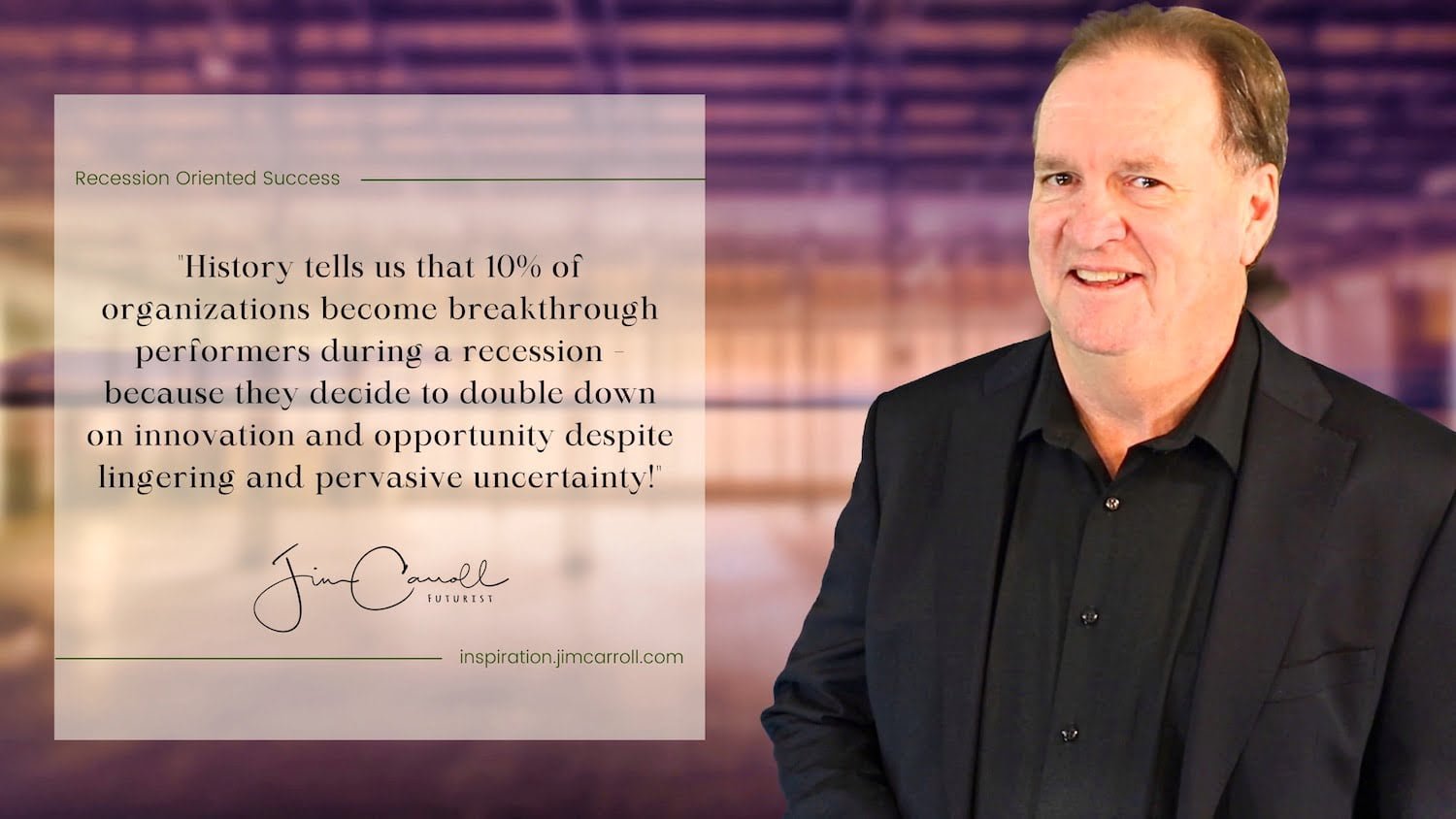
The keyword there is choice. The choice that you need to make right now is to focus on growth, particularly, growth through innovation.
The same thing proved to be true with the great economic downturn of 2008-2009 – some of the biggest disruptive innovations of our time were born in the ashes of the economic ruin of that era. Uber, Airbnb, and Tesla – all emerged or saw dramatic growth during one of the worst recessions of our time.
Recessions and economic volatility are opportunities – we know that through history! With that in mind, read this message I wrote to the CEO. This is the mindset choice I am seeing organizations make for 2023.
You can grab the PDF if you like! Share it now!
Memo to the CEO – 2022
To: CEO’s Worldwide
From: Jim Carroll
Date: May 19, 2022
I know things are extremely busy, particularly given the current climate of economic uncertainty. Yet, there is a key issue that you need to make sure is on your agenda.<
Innovation.
The most important thing that you can do right now, as you work to navigate your way through the challenging economic shoals that surround you, is to make sure that you don’t kill it in its tracks. My observations are that you risk doing so. That’s worrisome.
In the last few years, you’ve supported a core group of people in your organization who have become relentlessly focused on innovation, and you’ve created a culture that nurtures their efforts. They’ve been obsessively focused on process, service, and product innovation. They’re matching the needs of customers through accelerated innovation, are taking you into new markets through rapid product innovation, and are figuring out what to do in an economy that changes at a furious pace.
In the months and years to come, as volatility rages and we go into a new era of economic uncertainty, these executives are going to be some of the most important and critical individuals on your team.
So why is it they are telling me that they are finding less of a sense of urgency than a few months or a year ago? Is it the current climate of uncertainty, and a creeping culture of aggressive indecision?
Leaders set the tone. The tone you need to set for your leading innovators is that innovation matters now more than ever.
Here’s a key reality I have shared with my global clients through previous periods of economic uncertainty: only 10% of organizations become breakthrough performers during a recession – but that is because they have decided to double down on their innovation efforts. The other 90% become the marginal performers, the weak, the failures.
That’s why your innovation heroes are so important. These are the folks who are willing to stick their heads up, take a risk, and do something new and dramatic. It’s your innovation heroes who will help you to continue to open the future despite volatility and uncertainty.
You must ensure that they still have the courage to take risks. To open new markets. Accelerate the adoption of transformative technology. To realign the business for the future. To respond to rapid business model disruption. To continue to do what needs to be done to continue to run the business better, grow it, and transform it.
Celebrate them. Elevate them. Make their contributions known.
You have a momentary chance to ensure that you stay focused on the opportunities that come from your innovation heroes.
If you want to chat about this, give me a call. I’m here.
Sincerely,
Futurist Jim Carroll
Practical Steps.
Do these things to get into a growth-oriented mindset in 2023. Here’s what I’ve seen:
- Heighten the importance of innovation. One major client with several billions in revenue has 8 senior VP’s who are responsible for innovation. And the fact is, they don’t just walk the talk — they do it. The message to the rest of the company? Innovation is critical — get involved.
- Create a compelling sense of urgency. With product lifecycles compressing and markets witnessing fierce competition, now is not the time for studies, committee meetings, and reports. It’s time for action. Simply do things. Now. Get it done. Analyze it later to figure out how to do it better next time.
- Ignite each spark. Innovative leaders know that everyone in the organization has some type of unique creativity and talent. They know how to find it, harness it, and use it to their advantage.
- Re-evaluate the mission. You might have been selling widgets five years ago, but the market doesn’t want widgets anymore. If the world has moved on, and you haven’t, it is time to re-evaluate your purpose, goals, and strategies. Rethink the fundamentals in light of changing circumstances.
- Build up experiential capital. Innovation comes from risk, and risk comes from experience. The most important asset today isn’t found on your balance sheet — it is found in the accumulated wisdom from the many risks that you’ve taken. The more experiential capital you have, the more you’ll succeed.
- Shift from threat to opportunity. Innovative organizations don’t have management and staff who quiver from the fear at what might be coming next. Instead, they’re alive from breathing the oxygen of opportunity.
- Banish complacency and skepticism. It’s all too easy for an organization, bound by a history of inaction, to develop a defeatist culture. Innovative leaders turn this around by motivating everyone to realize that in an era of rapid change, anything is possible..
- Innovation osmosis. If you don’t have it, get it — that’s a good rule of thumb for innovation culture. One client lit a fuse in their innovation culture by buying up small, aggressive, young innovative companies in their industry. They then spent the time to carefully nurture their ideas and harness their creativity.
- Stop selling product, and sell results. The word solution is overused and overdone, but let’s face it — in a world in which everything is becoming a commodity and everyone is focused on price, change the rules of the game. Refuse to play — by thinking about how to play in a completely new game.
- Create excitement. I don’t know how many surveys I saw this year that indicated that the majority of people in most jobs are bored, unhappy, and ready to bolt. Not at innovative companies! The opportunity for creativity, initiative and purpose results in a different attitude. Where might your organization be on a “corporate happiness index?” If it’s low, then you don’t have the right environment. Fix that problem — and fix it quickly.
What are you doing right now to make sure that when you look back from January 15, 2020, you’re happy with the fact that you developed the right sense of purpose?
“You have three choices. You can panic. You can choose to do nothing. Or you can act, and begin to innovate, change and adapt for the inevitable upturn!” – Futurist Jim Carroll
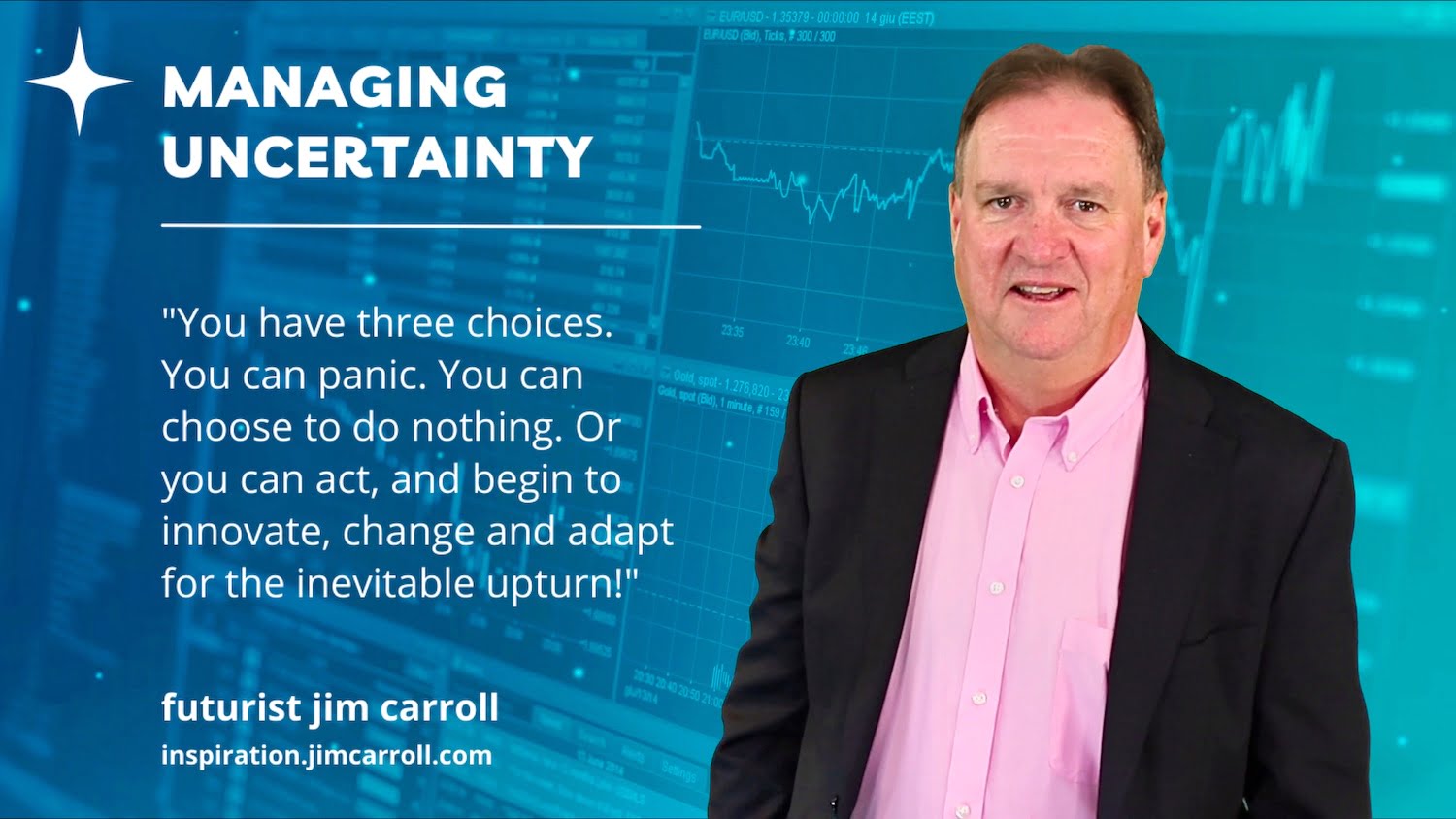
It’s pretty obvious that we’re going to have a recession, an economic downturn of sorts. It’s what you do with that fact that matters.
The unique context of what is now unfolding is going to be rather interesting. Since we’ve been in the longest period of economic growth in history – since early 2009 – we have an entire generation who have always known a stock market that only goes up, interest rates that always go down, home equity values that always increase, fictional assets such as crypto to make them feel rich and prices that always remain stable. All those assumptions are being tossed about with abandon, and it is interesting to watch their reaction. Add into this reality the fact that it seems a good portion of the population lives in a fictional political reality of moderate insanity, fed by their delusions of grievance, and, well, whoah!
I take it all in stride. By my count, I think this is the sixth economic downturn I’ve stared down in my career – I’m getting pretty good at them. I also found substantial business opportunities in the last two downturns, and plan to do so with this one – for me, it’s all about the opportunity! It was after the post-dot.com collapse of 2001 and the global economic meltdown of 2007-8 that I developed a global brand of being a go-to guy for advising global organizations on how to innovate through the recovery, booked by many global brands. Consider this video – I’m on stage with Yum! Brands (Taco Bell, Pizza Hut, KFC) talking strategies for moving forward in 2009 despite ongoing economic volatility.
Focus on growth. Nurture optimism. Pursue opportunity. It isn’t that hard. It’s what you do right now that matters. Economic downturns are but small blips on an ongoing trajectory of human progress. What I’ve learned over 30 years is that it is our ability to keep focused on the future in the face of massive uncertainty is that our ability to move forward defines our success.
With that in mind, you can:
- Freeze: do nothing
- Panic: make rash decisions on structure, markets, and investments.
- Innovate: respond to rapid market change through innovation, particularly with respect to strategies, structure, capabilities, markets, products, activities
The first choice won’t serve you well. Inaction is not a good choice, because markets, customers’ behavior, cost inputs, and just about everything else will change even faster now, and so you need to change faster. The second choice might seem to be the only response given the velocity of events as they occur, and it will be an unfortunate reality for some as this new era of volatility unfolds. But for others, panic will truly get you nowhere.
Option 3 — continuous innovation — remains the only thing to focus on. You need to work hard to align your current strategies with fast-paced economic events.
Why? History bears this out – here’s a clip where I’m referencing a very powerful study!
Everything you need to know is in this video!


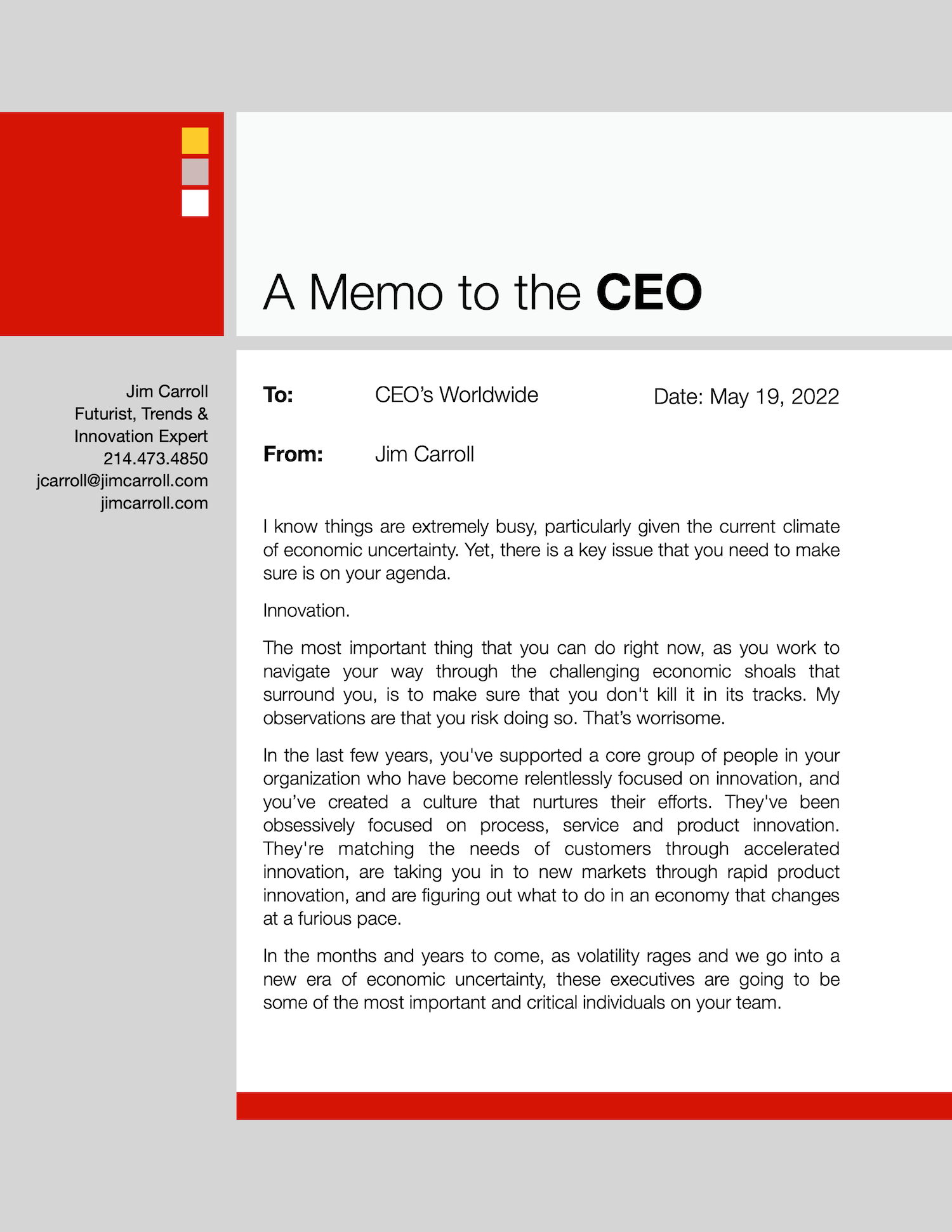
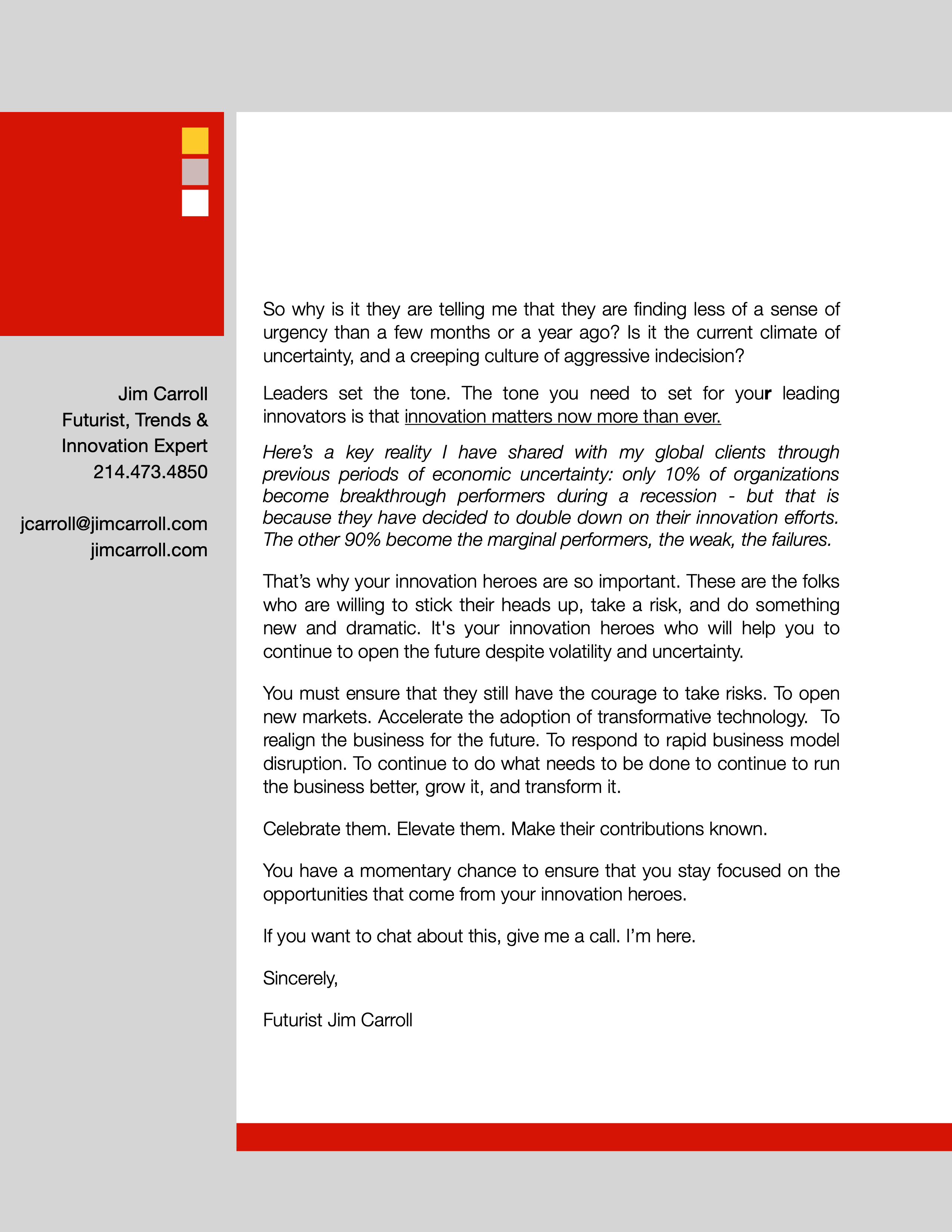


GET IN TOUCH
Jim's Facebook page
You'll find Jim's latest videos on Youtube
Mastodon. What's on Jim's mind? Check his feed!
LinkedIn - reach out to Jim for a professional connection!
Flickr! Get inspired! A massive archive of all of Jim's daily inspirational quotes!
Instagram - the home for Jim's motivational mind!